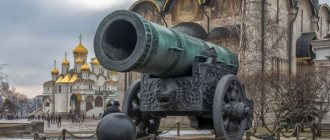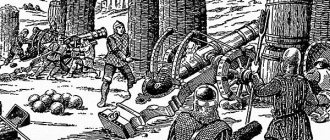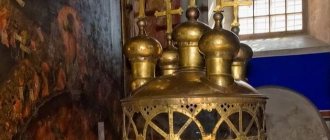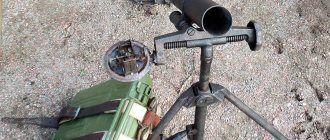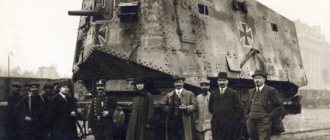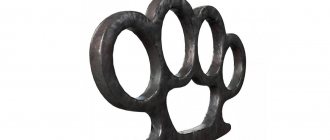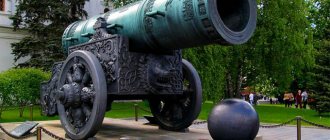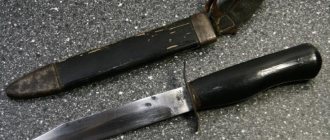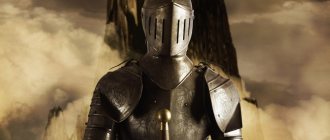The famous Tsar Cannon in the Kremlin, one of the most visited attractions in the Moscow Kremlin, can today be seen on the western side of Ivanovskaya Square. Each of the tourists arriving in Moscow must include in their visit an inspection of the grandiose weapon of the 16th century. A brief history of the Tsar Cannon for both children and adults is given in our article.
Cast in gigantic proportions from high-quality bronze, the cannon is even listed in the Guinness World Records. And this is not without reason. Here are just its most basic parameters:
- length - more than 5 m.,
- the outer diameter of the trunk reaches 134 cm,
- caliber - 890 mm,
- the product weighs about 40 tons.
When and why was it created?
Photo 1. The Tsar Cannon is one of the main attractions of the Kremlin
History of attractions for children in grades 1-2
By order of the sovereign, the master of the Cannon Yard in Moscow, Andrei Chokhov, cast in 1586 the Tsar Cannon , which was larger in size than all existing ones. They placed it on the ground near the Execution Ground to cover the Spassky Gate. After 40 years, it was installed on a manufactured log frame filled with earth. After another 10 years, they replaced it with a stone roll.
The image of the king with a scepter on the weapon allowed some historians to suggest the name of the weapon. Like, in honor of Fyodor Ivanovich, who was ruling at that time and issued a decree to make a cannon. Another part of the researchers is convinced that she was given the name solely because of her size.
Gun dimensions:
- 5.34 m - length;
- 120 cm - diameter;
- 39.31 t - weight;
- 890 mm - cal.
The parameters are impressive even for our time. Using such a weapon on campaigns required a lot of labor and effort. When delivering the gun from the cannon yard to the installation site, many people and 200 horses were involved.
Reasons for casting the Tsar Cannon
After the reign of Ivan the Terrible, who annexed Siberia, Astrakhan and the lands of Lithuania to Russia, which opened access to the Baltic Sea. The state has significantly increased the number of enemy countries, with which by the end of the 16th century. signed dubious peace treaties that resembled a respite.
During the reign of Ivan IV the Terrible, the Muscovite kingdom waged wars with the Crimean Khanate and European countries:
- Denmark;
- Sweden;
- Polish-Lithuanian Commonwealth.
After the reign of a strong tsar, his weak son Fyodor Ivanovich, nicknamed the Blessed, did not appear to the people as a defender of the fatherland. Moreover, Russia, which was at war with the Crimean Khanate, was often subjected to Tatar raids.
Muscovites feared for their lives and acquired property, especially after the attack of Khan Devlet Giray, which ended with the burning of the outskirts of the capital. Then the king issued a decree to create a weapon that would terrify the enemy and instill peace in his subjects.
Manufacturing
By decree of the Tsar, a cannon for hanging buckshot was made at the Moscow Cannon Yard, which was superior in caliber to all others.
The idea of creation came from Boris Godunov, who was the brother-in-law of the Tsar and had significant power in the state. They poured it in a furnace with high melting technology, for those times, which made it possible to heat tens of tons of metal and cast a weapon of similar size.
Rearrangements
The Tsar Cannon (the story briefly tells about its rearrangements) moved around the Kremlin with the participation of a large number of people and 200 horses, which pulled it, rolling it over logs. The second time, in this way, it was rearranged in the 18th century, in connection with the construction of the Arsenal in the Kremlin and the installation of a cannon in its courtyard with other guns.
During the Patriotic War with the French, in 1812, Napoleon, retreating from Moscow, ordered the Arsenal to be blown up. As a result, the guns of most of the Arsenal were damaged and the gun carriages were burned. The Arsenal was restored in 1817, and the Tsar Cannon was placed at the gate. Two years have passed. The architect Henri Montferrand had the idea to erect a memorial composition dedicated to the historical victory of Russia in the War of 1812.
The project implied the location of the Tsar Cannon and another large-caliber weapon, the Unicorn, near the entrance to the Arsenal.
They were to be installed on wooden carriages, painted green, with black wrought iron decorations. The approved project was not implemented.
The idea to install a cannon at the main gate of the Arsenal was realized in 1835. By that time, a cast iron carriage, decorated with bas-reliefs to match the barrel, and painted in bronze color, was ready in St. Petersburg. Along with it, 4 cores were added to the composition, weighing 1970 kg each. The cannon has been preserved in this form to this day.
Eight years later, in 1843, the cannon was moved to the Armory. Where it stood until 1960, when the building in which the barracks were then located was demolished to free up the territory for the construction of the Palace of Congresses. The gun was then installed on the north side of the Ivan the Great Bell Tower, where it stands now.
Tsar Cannon today
Now it is exhibited as a commemorative composition of Russian artillery and foundry, symbolizing the power of the state and a strong army.
Experts recognized the Tsar Cannon as the largest caliber weapon of the Middle Ages, so it was included in the Guinness Book of Records. Where she held the championship until graduation in the 19th and early 20th centuries. 914mm caliber weapons.
The trunk is decorated
The barrel is decorated with elegant ornaments, giving the Russian shotgun artistic value. In the front, muzzle part on the right, Tsar Fyodor Ivanovich is depicted wearing a crown, on a horse, with a scepter. At the top is an inscription containing a complete listing of the king's titles.
On the middle part, on the right, is the order to create a cannon, where the name of the queen, Grand Duchess Irina, is mentioned. On the left is information about the place of manufacture and the date indicated in the Old Slavonic style, from the creation of the world, “….year 7094...”, with the name of the foundry worker.
“Scary” impression on foreigners
There is evidence that Tsar Fyodor Ioannovich ordered the production of a large weapon for the war with the Crimean Khan. But it is likely that the Tsar Cannon’s task was only to frighten foreign ambassadors with its power.
The cumbersome weapon was not going to be used in battle. Andrey Chokhov could have known about this at the design stage. The master had to give answers to the main questions:
- Will the barrel remain intact after the gunpowder is ignited? To fire a 120-pound cannonball, you need a huge amount of it.
- Heavy weight. It's hard to imagine a clumsy weapon in battle. Changing positions would be an insoluble problem.
- Recharging would take a day.
The cannon became a symbol of Russia's superiority over potential enemies . The gunsmith managed to show the potential of the domestic foundry. Chokhov’s logic is simple - if the Russians created a large weapon, then it will be easy for them to make similar ones of smaller calibers.
What does the Tsar Cannon look like?
If at first the barrel lay on the ground, then it was then placed on a carriage, creating a memorable composition with cannonballs and a tablet containing brief information about the cannon, its mass, each cannonball and carriage. All exhibits fit perfectly together, although they were made at different times and by different masters. The gun carriage with the cannonballs for the barrel was made almost 250 years later.
The decorations of the barrel are combined with relief images of the carriage, emphasizing the status of the gun. A particularly large lion head, in the front center, just below the trunk. And among a strikingly beautiful pattern in the form of intertwined plants, a lion is depicted slaying a snake. In front of the guns are four cannonballs, laid out in a pyramid.
Imperial portraits
Peter Drozhdin. Portrait of Peter the Great. 1795. Timing
Gregory of Musikiy. Portrait of Peter I. 1723. State Hermitage
Paul Delaroche. Portrait of Peter the Great. 1838. Hamburg Kunsthalle
The young Russian Empire needed guns in such huge quantities that at first Peter I took bells from monasteries and poured them into cannons - there was not enough metal. In 1701, about 180 tons of bronze were collected and 268 guns were cast from it. Then they managed to boost industry - they built weapons factories and found Ural deposits.
Firearms ruled the world. Therefore, it penetrated into the portraits of sovereigns, who were previously depicted in armor and with swords. With a cannon at hand, a symbol of victory, Peter is depicted by his favorite miniaturist Gregory of Musikiy. In addition to the muzzles of guns, there are other signs of imperial achievements around - ships, the Peter and Paul Cathedral. One of the most recognizable images of Peter, a painting painted by Paul Delaroche already in Nicholas’s time, also could not do without a gun barrel.
Design features
The weapon, according to the conclusion of the historian, A.N. The lobina, according to the type of barrel, is a bombard. This type of weapon allows us to classify the ratio of caliber to barrel length as 3.4. For a classic gun, the length should correspond to 40 calibers or more. However, it was also different from the traditional bombard.
Distinctive features:
- narrow, in relation to these dimensions, charging chamber 440X1740 mm;
- trunk diameter at the base is 890 mm;
- diameter at the muzzle 920 mm.
The data is typical for powerful siege artillery weapons. However, transporting it on hikes, given its weight and size, is very problematic, without cranes and tractors.
To fire a shot, shotguns of this size took a whole day to load. Using a weapon with such characteristics for defensive purposes was most appropriate. In this case, they did not need to be transported anywhere.
Device
The Tsar Cannon is a typical bombard . The narrow charging chamber transforms into a wide barrel. The breech ends with a flat bottom for digging into the ground. This structure distinguishes a siege weapon from a field weapon.
In old documents the gun is listed as a “Russian Shotgun”. It was intended for firing shot at the enemy. But this cannot be said unambiguously based on the design.
Heavy guns fired stone cannonballs to break through the fortress walls. At the foot of the cannon there are 4 hollow cast iron cannonballs. Each weighs 1.97 tons. They were cast together with the gun carriage in 1835 in St. Petersburg. This is just a prop. The cannon cannot fire such cannonballs. The barrel will be blown apart due to the enormous weight of the charge.
Similar cannons were loaded with 750-kilogram stone cannonballs or buckshot . The guns were classified as bombards. The Tsar Cannon is a real bombard.
Interesting Facts
Whether the cannon was made for defense, as a full-fledged weapon or as a decorative commemorative item, researchers argue. They are interested in whether it is possible to fire a shot. The cannonballs standing by the cannon certainly cannot be used as a projectile. A charge of gunpowder would rupture the barrel using such a core.
The idea to make a shotgun of this size could have originated with Ivan the Terrible. A well-known customer, other huge guns, slightly smaller in size and caliber, but military, used in campaigns.
In those days, success in capturing cities depended on the presence in the arsenal of weapons of similar caliber, with the help of which they broke down walls. But I didn’t have time to implement it due to death. So Boris Godunov, being close to Ivan IV (the Terrible), put forward the idea of the deceased tsar.
The Tsar Cannon, which has historical value, pride and the calling card of the country, was decided to be restored shortly before the 1980 Olympics. While restoring it, the experts conducted an examination, after which they briefly commented that the weapon was made for mounted fire with small cannonballs (buckshot). But for some reason they did not find the pilot hole, putting an end to the dispute between groups of scientists about the purpose of the weapon.
According to the conclusion of the expert commission, the weapon is made according to the standards of Artillery weapons, as a combat weapon, but it is impossible to fire a shot due to the lack of a hole for installing a fuse.
Tour route:
1 day:
Meeting the group at the railway station.
Sightseeing tour “Your Capital”.
You will pass through the central streets and squares, the most beautiful corners of Moscow and legendary places that are cultural and historical heritage, such as: the Moscow River embankment with a panorama of the Kremlin, the Cathedral of Christ the Savior and Sparrow Hills, Poklonnaya Hill with Victory Park and the Triumphal Arch, Moscow State University and Moscow City, Garden Ring and Novodevichy Convent, Zamoskvorechye and Zaryadye. You will not only hear history, but also see the modern appearance of our ancient capital.
Hotel accommodation.
/Transport is provided for 5 hours. /
Day 2:
Breakfast in the hotel cafe.
Meeting with the guide in the hotel lobby.
Excursion to Red and Manezhnaya squares, Alexander Garden.
On the excursion you will hear the fascinating history of these famous objects, as well as the Kremlin and its towers: Nikolskaya, Spasskaya, Senate, Arsenalnaya, Tsarskaya, Nabatnaya, etc., GUM and St. Basil's Cathedral, Kazan Cathedral and the Historical Museum, Execution Place and the Monument to Minin and Pozharsky, the Tomb of the Unknown Soldier, the Ruins grotto, the Manege and other things that constitute our cultural heritage.
Excursion to the Kremlin territory with a visit to the cathedral.
The Moscow Kremlin is located in the very center of the Russian capital. The Kremlin ensemble is included in the UNESCO World Cultural and Natural Heritage List and on its territory there are majestic cathedrals and temples, a magnificent palace ensemble, the Arsenal, the Senate, the Tsar Cannon and the Tsar Bell.
/Transport is not provided./
Day 3:
Breakfast in the hotel cafe.
Meeting with the guide in the hotel lobby.
Tour of the Moscow metro.
The capital's subway will surprise you with the variety and intricacy of its architecture, and the underground galleries will amaze you with their grandeur. You will drive through and see the most famous and extraordinary stations of the Moscow metro, hear the history of the creation, difficulties, curiosities, legends and secrets of this amazing structure.
Walking tour of Old Arbat.
The most famous pedestrian street in Moscow will share with you its history, stories about the amazing people who lived here, secrets that have sunk into oblivion. An exciting walk awaits you from Pushkin’s apartment, to Tsoi’s wall and the Prague restaurant.
Excursion to the Tretyakov Gallery.
This excursion will open the doors to the world of the richest collection of masterpieces of Russian painting, collected thanks to the efforts of P.M. Tretyakov. The scope of the collection in the museum is amazing; all Russian artists are represented here, and the directions of painting from the mid-19th to the beginning of the 20th century: from the historical motifs of Flavitsky, portraits of Kramskoy, landscapes of Levitan, to the emergence of cubism in the works of Vrubel.
Return to the hotel by public transport.
/Transport is not provided./
Day 4:
Breakfast in the hotel cafe.
Meeting with the guide in the hotel lobby.
Excursion “Moscow streets”.
The history of a city is, first of all, the history of its streets. You will get acquainted with the famous Moscow streets and learn the history of Tverskaya, Petrovka, Neglinnaya, Myasnitskaya, Mokhovaya, Znamenka, Vozdvizhenka, New Arbat and other equally important arteries of the ancient capital.
Excursion to the Mosfilm film studio.
Mosfilm is the door that opens the veil of secrecy over the magic of cinema. Several halls of the museum contain sets from the most famous films, taking you into the world of long-familiar and famous films. You will be amazed by the exhibition and the story about the inner life of the kitchen in the world of cinematic illusions.
Return to the hotel by public transport.
/Transport is provided to Mosfilm./
Day 5:
Breakfast in the hotel cafe.
Meeting with the guide in the hotel lobby.
Excursion-acquaintance with the All-Russian Exhibition Center.
The Exhibition of Achievements of the National Economy (VDNKh), famous throughout the Soviet Union, has still retained its former grandeur; the architectural masterpieces of the pavilions of the republics and industries, spread over 238 hectares, tower over the alleys and squares. The famous and unique fountains of Friendship of Peoples and the Stone Flower are pleasing to the eye.
Further excursion services to choose from:
- Excursion to the Polytechnic Museum, exhibition “Russia does it itself.”
Visitors will be treated to scientific and technical developments by legendary Russian scientists, exhibits from the collection of the Polytechnic Museum, multimedia and interactive objects, and the opportunity to conduct experiments and conduct independent experiments.
- Excursion to the Robot Station.
Robostation is an interactive exhibition in one of the most beautiful pavilions at VDNKh. Here are robots from different countries of the world with their own stories and characters, a triumph of engineering science and technology. The robot station was created by an international team passionate about robots and engineering for communication, gaining new experience, useful knowledge and vivid impressions. Unlimited time at the exhibition, Interactive zone and creation of robot heads, Robot dance show, 2000 sq. m of scientific and entertainment space
Return to the hotel by public transport.
/Transport is not provided./
Day 6:
Breakfast in the hotel cafe.
Meeting with the guide in the hotel lobby.
Visit to the Moscow Zoo.
The first zoo in Russia, opened in 1864. Its creation was initiated by the Imperial Russian Society for the Acclimatization of Animals and Plants, and the zoo was largely maintained by donations from the imperial family. Now it contains about eight thousand individuals belonging to approximately one thousand one hundred species of the world fauna. Animals of the Moscow Zoo are kept in several dozen exhibitions representing a particular region, family, species, etc.
Return to the hotel by public transport.
/Transport is not provided./
The Mystery of the Tsar Cannon
The lack of documented evidence of the gun's participation in combat or test firing led to lengthy debate. Military and historical researchers of the 19th and early 20th centuries primarily considered it a military weapon.
It is still unknown whether the Tsar Cannon ever fired
Some ruled out combat use, suggesting that it was originally made with the intent to impress foreigners.
Other researchers believe that the Tsar Cannon fired at least once . This can be evidenced by the master's mark inside the barrel, which was allowed to be placed only after a test salvo. Their opponents refute the possibility of a shot by the remains of bronze in the barrel chamber, which do not remain there after shooting. Reinforcing the position with the obvious conclusion, the absence of a fuse hole.
The Tsar Cannon (history briefly describes the events affecting the operation of the gun, so few facts about the monument have been preserved today) after its manufacture was installed as a defensive weapon against the Crimean Tatars. And, according to historical events, there are known facts of the use of guns in battles, in particular bombards, with a slightly inferior caliber.
The table provides brief data on other large-caliber combat bombards:
Pumhart von Stey
| Name | View | Caliber | Date of manufacture | A country |
| Pumhart von Stey | Bombard | 820 | beginning of the 15th century | Habsburgs, Austria |
| Faule Mette (Lazy Mette) | Bombard | 735 | 1411 | Germany Braunschweig |
| Crazy Greta | Bombard | 660 | XIV century | City of Ghent, Holy Roman Empire |
| Basilica | Bombard | 650 | 1464 | Ottoman Empire |
| Faule Grete (Lazy Grete) | Bombard | 520 | 1409 | State of the Teutonic Order |
| Mons Meg | Bombard | 520 | 1449 | Duchy of Burgundy |
| Unknown | Bombard | 510 | 1480 | Hospitallers Order of St. John |
Despite the fact that they were cast even earlier, almost 100 years ago. If so, then the Russian shotgun could have fired, but it didn’t have to.
Faule Mette
The fact that the cannon was made as a military weapon, and not as a prop, is indicated by the fact that when the Tatar army approached in 1591, it was put on combat readiness, along with all the capital’s artillery. Having established the defense of the main Kremlin gates.
Short description
The weight of the Tsar Cannon is 39.31 tons , length is 5.34 meters . Gun caliber 890 mm . The outer diameter of the trunk is 1.2 meters .
The bronze barrel is mounted on a cast-iron decorative carriage. The solemn and regal image of the miracle gun is given by:
- Belts with ornaments.
- Image of the king on horseback.
- Figured friezes.
- Memorial inscriptions.
Cast iron cores are laid nearby. They were cast in 1834. Each weight is 1.97 tons . The cannonballs emphasize the monumentality of the Tsar Cannon. It's impossible to shoot like that.
The Legend of the Tsar Cannon
The Tsar Cannon (history briefly mentions it in the legend of False Dmitry) shot the ashes of the impostor towards the Polish-Lithuanian Commonwealth, where he was born. False Dmitry and his exposure are historical facts distorted by speculation in folk legends.
According to legend, after exposure, False Dmitry sought to escape from Russia, but on the way he met people’s militias who brutally killed him. But the body, a day after the funeral, was found near the shelter.
They decided to bury him in such a way that he would not come out again, but this action did not bring any results, he was discovered again in another cemetery. They thought that the Russian land did not accept this, so they burned the corpse, and the collected ashes were mixed with gunpowder and sent back where they came from, fired from a cannon.
The legend traces the attitude of the people towards the legendary weapon. During times of unrest and anarchy, the murdered impostor was buried in the ground, but he reappeared among the living. The common people decided that their land was rejecting them and the mission to drive the troublemaker out of our lands was decided to be entrusted to the Tsar Cannon, the defender of the Russian people.
Tour route:
Monday:
09:40 meeting with a guide at the monument to Marshal Zhukov. /Okhotny Ryad metro station, exit towards the Historical Museum./
The famous treasury museum will introduce you on a tour to outstanding collections of royal regalia, vestments of emperors and empresses, precious relics made by Kremlin craftsmen, and gifts from embassies of other countries; will tell you about the history and ownership of unique exhibits of ceremonial and military weapons, ceremonial horse harness and royal carriages, a priceless collection of gold and silver masterpieces belonging to monarchs.
Visit to the Kremlin territory with cathedrals.
The Moscow Kremlin is located in the very center of the Russian capital. The Kremlin ensemble is included in the UNESCO World Cultural and Natural Heritage List, and on its territory there are majestic cathedrals and temples, a magnificent palace ensemble, the Arsenal, the Senate, the Tsar Cannon and the Tsar Bell.
Finishes in the city center at 14:00.
Tuesday:
13:00 meeting with the guide at the Ploshchad Revolyutsii metro station. /The group gathers in the center of the platform between the trains./
Walking tour of Old Arbat.
The most famous pedestrian street in Moscow will share with you its history, stories about the amazing people who lived here, secrets that have sunk into oblivion. An exciting walk awaits you from Pushkin’s apartment, to Tsoi’s wall and the Prague restaurant.
Excursion to the Mosfilm film studio.
Several halls of the museum contain sets from the most famous films, taking you into the world of long-familiar and famous films. You will be amazed by the exhibition and the story about the inner life of the kitchen in the world of cinematic illusions.
Finishes near Mosfilm at 17:00.
For those who wish, a visit to the Moscow City observation deck with unlimited tasting of ice cream and chocolate (for an additional fee).
Wednesday:
10:00 meeting with the guide at the Ploshchad Revolyutsii metro station. /The group gathers in the center of the platform between the trains./
Tour of the Moscow metro.
The capital's subway will surprise you with the variety and intricacy of its architecture, and the underground galleries will amaze you with their grandeur. You will drive through and see the most famous and extraordinary stations of the Moscow metro, hear the history of the creation, difficulties, curiosities, legends and secrets of this amazing structure.
Excursion to the Tretyakov Gallery.
This excursion will open the doors to the world of the richest collection of masterpieces of Russian painting, collected thanks to the efforts of P.M. Tretyakov. The scope of the collection in the museum is amazing; all Russian artists are represented here, and the trends of painting from the mid-19th to the beginning of the 20th century: from the historical motifs of Flavitsky, portraits of Kramskoy, landscapes of Levitan, to the birth of cubism in the works of Vrubel.
Ends near the Tretyakov Gallery at 14:00.
Thursday:
10:00 meeting with a guide at the Ploshchad Revolyutsii metro station for those staying at the Zarya, Irbis, and Sherston hotels.
10:20 meeting with a guide on the platform between trains at the Botanical Garden metro station for those staying at the Tourist Hotel.
Excursion “Legends and Myths of VDNKh”.
The Exhibition of Achievements of the National Economy (VDNKh), famous throughout the Soviet Union, has still retained its former grandeur; the architectural masterpieces of the pavilions of the republics and industries, spread over 238 hectares, tower over the alleys and squares. The famous and unique fountains of Friendship of Peoples, Stone Flower and Kolos are pleasing to the eye. You will hear the history of the exhibition, which is a reflection of the history of our country, with each turn of which VDNH grew and expanded, grew old and destroyed, changed and supplemented.
Excursion to the Robot Station at VDNKh.
Robostation is the world of robots and artificial intelligence in our lives; you will discover the amazing achievements of modern machines. Robots that can communicate, swim underwater and even dance.
Finishes at the All-Russian Exhibition Center at 13:00.
Optional visit to the Moskvarium (for an additional fee).
Friday:
10:00 meeting with a guide at the monument to Marshal Zhukov. /Okhotny Ryad metro station, exit towards the Historical Museum./
Excursion to Red and Manezhnaya squares, Alexander Garden.
On the excursion you will hear the fascinating history of these famous objects, as well as the Kremlin and its towers: Nikolskaya, Spasskaya, Senate, Arsenalnaya, Tsarskaya, Nabatnaya, etc., GUM and St. Basil's Cathedral, Kazan Cathedral and the Historical Museum, Execution Place and the Monument to Minin and Pozharsky, the Tomb of the Unknown Soldier, the Ruins grotto, the Manege and other things that constitute our cultural heritage.
Sightseeing tour “Your Capital”.
You will pass through the central streets and squares, the most beautiful corners of Moscow and legendary places that are cultural and historical heritage, such as the Moscow River embankment with a panorama of the Kremlin, the Cathedral of Christ the Savior and Sparrow Hills, Moscow State University and Moscow City, the Garden Ring and the Novodevichy Convent, Zamoskvorechye and Zaryadye. You will not only hear history, but also see the modern appearance of our ancient capital.
Ends on Red Square at 14:30.
Saturday:
10:00 meeting with a guide in the center of the hall of the Park Pobedy metro station.
Excursion to Poklonnaya Hill.
Every step, pillar, height of the obelisk - everything in the memorial complex is filled with the deepest meaning and symbolism associated with the great war, victory and eternal memory. The park was opened in honor of the 50th anniversary of the victory. In addition to the memorial and the eternal flame, you will see temples of three religions built in honor of fallen soldiers, a galaxy of famous monuments from the victims of the Holocaust to the monument to the Allied wars.
Excursion to the Central Museum of the Great Patriotic War.
You will get acquainted with the main military-historical exhibition of the museum, with the most important events of the Great Patriotic War, learn about outstanding warriors and commanders, and about the heroic work of the rear.
Ends near the Museum of the Great Patriotic War at 14:00.
Sunday:
10:00 meeting with the guide in the lobby of the Zarya Hotel (for residents of the Zarya and Irbis hotels).
10:15 meeting with the guide in the lobby of the Sherston Hotel (for tourists staying there).
10:40 meeting with the guide in the lobby of the Tourist Hotel (for tourists staying there).
Bus excursion to the Kolomenskoye estate museum.
Since the 14th century, Kolomenskoye has been a country summer residence of the great Moscow princes and Russian tsars. It was here that the famous palace of Alexei Mikhailovich Romanov, nicknamed by his contemporaries “the eighth wonder of the world,” was once located. You will see and learn the history of the Sovereign's court, the palace, the Church of the Kazan Mother of God and the Church of the Ascension of the Lord, which is under the protection of UNESCO, morals and customs observed for centuries, curiosities and milestones in the history of the estate and the rulers whose fate was inseparably connected with it.
Visit to the Front Gate Museum.
You will get acquainted with the exhibition, which includes recreated executive chambers where the sovereign's affairs were decided, a collection of ancient books, rare icons, weapons and ammunition, a model of the palace of Alexei Mikhailovich, preserved manuscripts and documents, outfits and dresses, clock and bell mechanisms in the chamber of Lviv's roar, archaeological exhibits and personal belongings of monarchs.
Ends at the square of three stations (Komsomolskaya metro station, Leningradsky, Yaroslavsky, Kazansky stations) at 14:00.
Tsar Cannon and its copies
Two exact copies of the Kremlin original were made at the Izhevsk arms plant in 2001. One was solemnly presented to the city of Donetsk, and the second was placed near the entrance to the plant.
Donetsk received a copy of the original gun as a gift from the Moscow administration, in response to the gift of a copy of Mertsalov's Palm to Moscow. They installed the delivered gift near the Donetsk City Council, in the direction directly from the building, symbolically protecting it.
The copies, generally identical to the original, are made of cast iron, with barrels 6 cm shorter, which was carried out by order of the museum's management. The weight of the barrel was 44 tons, the carriage - 20 tons.
If 2 guns made in Izhevsk are completely identical to the original, then those in Yoshkar-Ola are not an exact copy. It is 2 times smaller, cast from steel and part of the relief pattern is changed or missing. The cannon was manufactured at the Zvenigovsky shipyard, completely suitable for firing, so a cannonball was installed in the barrel.
Amsterdam Embankment
During our excursion to the sights of Yoshkar-Ola, we will visit the Amsterdam embankment. This place is one of the most popular for a leisurely promenade and relaxation.
What can you see
The embankment is cozy and small in area, but despite this there are several interesting objects installed here.
- The sculpture “Pushkin and Onegin” - it is located at the beginning of the embankment; the sculptural composition depicts a dialogue between the author and his hero. Alexander Sergeevich is sitting on a bench, and Evgeny Onegin is standing a little away from him.
- Monument to N.V. Gogol - a bronze sculpture was installed on November 4, 2012. The author of the work was the sculptor A. Kovalchuk.
- Monument to Rembrandt - the grand opening of the monument took place on October 31, 2013. The sculpture depicts the artist at the moment of creativity, in his hands he has a palette, brushes, and a grinder. The monument was cast from bronze in Zhukovsky; according to some sources, it took about 950 kilograms of bronze and 3.5 tons of granite stone to create it.
The embankment and its architectural ensembles are made in traditional Dutch style
How to get there
The Tsar Cannon is located in Moscow, on Ivanovskaya Square, in the Kremlin. If you take the metro, we find one of the stations close to the Kremlin - “Alexandrovsky Garden”. Through the pedestrian crossing, it is easier to get to the ticket office to purchase tickets for a tour of the Kremlin.
You can walk a short distance from the station, going to the Kremlin through the Trinity Tower. From the tower, heading towards the historical relic of Russian artillery art, walk past the Palace of Congresses to the Tsar Cannon, located on the western side of Ivanovo Square.
Article design: Mila Friedan
Opening hours and ticket prices in 2022
Tourists can come and see the artillery monument on all days of the week except Thursday. From May 15 to September 30, the attraction welcomes tourists from 9:30 a.m. to 6 p.m. From October 1 to May 14, the Tsar Cannon welcomes guests from 10 am to 5 pm.
To get to the Kremlin territory, you should buy a single ticket to visit the architectural ensemble of Cathedral Square. It will allow you not only to see the Tsar Cannon, but also to watch the Ceremonial Dividing of the Horse and Foot Guards of the Presidential Regiment. The ceremony takes place at noon on Saturdays.
The ticket costs 700 rubles. Tickets are sold to pensioners and full-time students at a discount - for 500 rubles.
© Maria Penina
British brutality
Vasily Vereshchagin. Suppression of the Indian Rebellion by the British. 1884
Vasily Vereshchagin. A gun. Study for the painting “English Execution in India.” 1882-1883
The British generally behaved at that time as masters of the world. However, they almost were: it was not for nothing that the sun never set in the British Empire, which included both Australia and Canada. This power was facilitated by their advanced technology, especially military technology.
Vasily Vereshchagin, who was in love with Asia and made many trips through it, could not neglect the English cannons that ruled this continent. Moreover, the British came up with a method of capital punishment that was difficult to forget once seen. He was nicknamed “the devil’s wind”: the condemned man was tied to the muzzle of a cannon, and then fired from it. The executed person could not even be buried properly after this, which was especially difficult for religious Hindus.
In 1884, Vereshchagin painted a painting that depicts a row of cannons with Indians tied up moments before firing. This painting is now known only from a reproduction - in Europe it caused such a big scandal and indignation at English barbarism that someone bought it (the British) and destroyed it.

